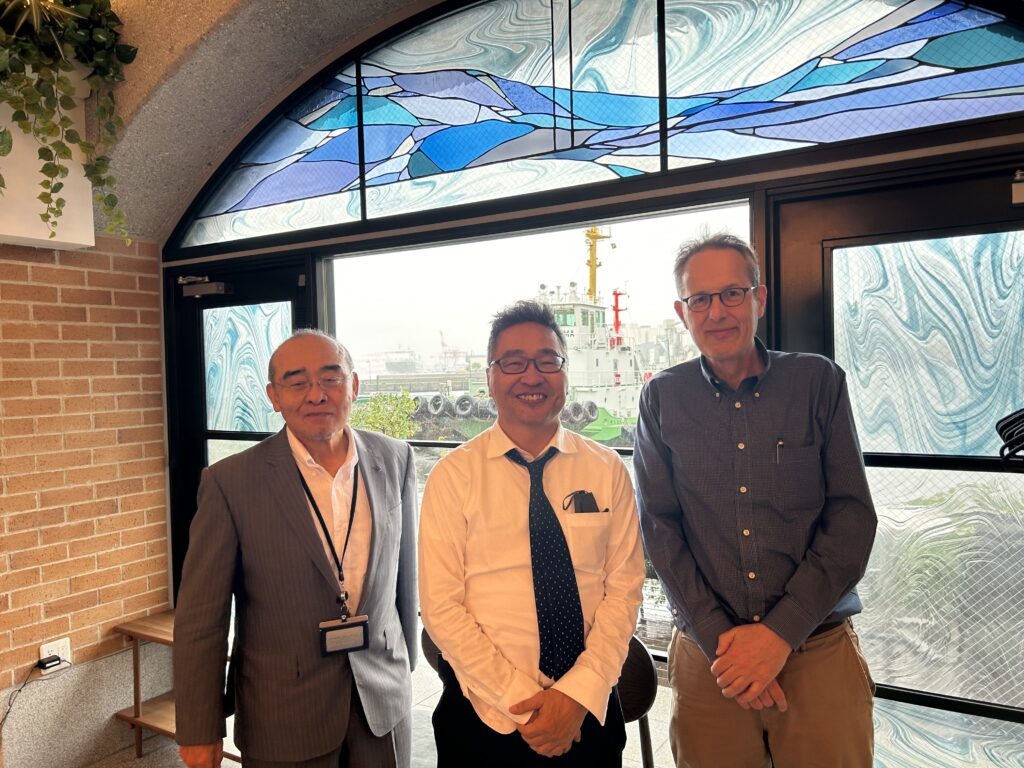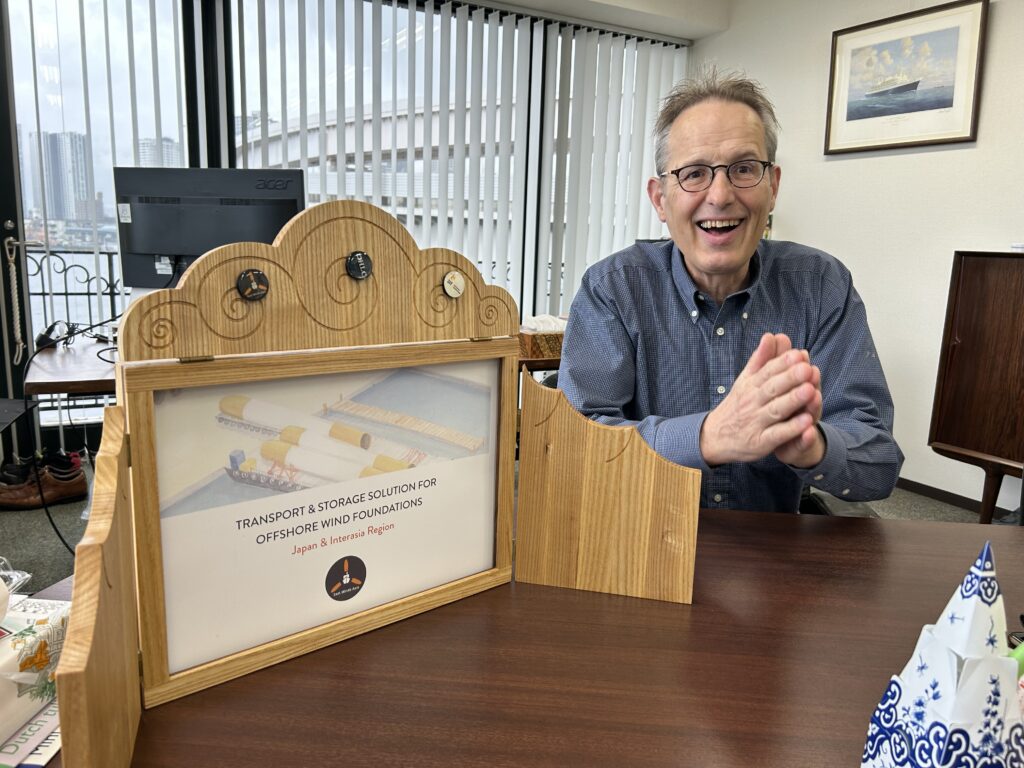
〆East Winds Asia Pioneers Techniques for Handling Offshore Wind Foundations in Japan’s Space-Constrained Ports
May 1, 2024 — As most workers around the globe enjoy a day off for May Day and Japan revels in the midst of Golden Week, I was navigating my way to the Tokyo Bayside Building in the Minato coastal district of Tokyo amidst escalating rain and winds. Hailing a taxi at Shinbashi, I informed the driver of my destination, and we set off along the Metropolitan Expressway’s Odaiba Line. My driver, nervously admitting it was his first day, soon confessed, “I’m sorry, I can’t manage to get us there.”
Upon arriving, I understood his concern. The building stood prominently next to the Pilot Building, directly beneath the Rainbow Bridge, with a commanding view of Tokyo Bay along the cutting edge of Shibaura’s coastal road. Its red-brick facade exuded a refined charm.

Upon reaching the fourth-floor office, I was greeted by Mr. Justus Schoemaker and Mr. Dmitrii Grechushkin. Mr. Schoemaker, a man with 30 years of experience as a merchant ship captain, is the president of the Dutch-Japanese Maritime Desk, a company rooted in the Netherlands but based in Tokyo since its inception in December 2013. He is also a director at Finsulate, a company known for its eco-friendly antifouling materials for ship hulls.
Originally, my visit was meant for a casual lunch with the well-acquainted Mr. Schoemaker. However, he introduced me to Mr. Masamori Shibuta, president of Shibuta Kaiun, a tugboat operator and owner of vessels up to 12,000 deadweight tonnage, and the building’s proprietor.
Mr. Schoemaker and Mr. Shibuta have collaborated to co-found East Winds Asia. This joint venture between Dutch-Japanese Maritime Desk, Shibuta Kaiun, and their Dutch partner DHLC focuses on facilitating the adoption of offshore wind power in Japan, developing methods for transporting and storing massive wind turbine foundations in limited space and high endurance ports.

Their partnership illuminates significant challenges. “Ports in Japan and other Asian countries are currently ill-equipped for the offshore wind foundation facilities, which now weigh as much as 2,000 tonnes. Only a handful of ports can handle over 1,000 tonnes without major investment,” they noted.
As a leader in offshore wind technology, transportation, and expertise, the Netherlands is a crucial partner. East Winds Asia aims to integrate large barges and Crew Transfer Vessels (CTVs) in collaboration with Dutch firms, paving the way for a sustainable energy future in Japan. This initiative not only addresses logistical challenges but also sets a precedent for international collaboration in renewable energy infrastructure development.
〆私はEast Winds Asiaが本社を置く東京ベイサイドビルを訪問した。
〆East Winds Asiaは日本の洋上風力発電の導入を念頭に、限られたスペースと地盤耐力のある港で洋上風力基礎を輸送・保管する方法を検討している。
2024年5月1日。海外ではメーデーで労働者は休み、日本はゴールデンウィークの中日である。
雨と風が強まる中、私はその日、東京港区海岸の東京ベイサイドビルを目指していた。私は新橋でタクシーに乗ると運転手にそのビルの住所を告げた。カーナビゲーションは首都高速お台場線のルート上を示す。最初に乗車したタクシーの運転手は今日が初日だという。運転手は次のように話した。「すみません。私の運転ではここにたどり着けません」
私は現地に到着してタクシー運転手の言っていたことを理解した。
そのビルは、水先案内人のビルの真横にあり、レインボーブリッジの真下、東京湾を目前に臨む、芝浦の海岸通りの最先端に位置するのだ。
そのビルの外観は赤レンガで、瀟洒な雰囲気を漂わせる。
私が4回のオフィスに行くとMr.Justus SchoemakerとMr.Dmitrii Grechushkinの2人が出迎えてくれた。Mr. SchoemakerはDutch- Japanese Maritime Desk 株式会社の社長である。Dutch- Japanese Maritime Deskはオランダにルーツを持つ日本企業で、東京に本拠を置き、2013年12月に設立された。Mr. Schoemakerは30年にわたる商船の船長の経験を持ち、オランダと日本の海洋産業に関わってきた。
Mr. SchoemakerはDUJAM Deskだけでなく、船底塗料を使わず環境に優しい船底用防汚材を提供するFinsulate社の役員でもある。
当初、私の訪問目的は従来から既知のMr. Schoemakerとランチを共にすることだった。しかし、Mr. Schoemakerは私にそのビルの所有者であり、タグボート事業、1万2000重量トン級の近海船の船主でもある渋田海運(Shibuta Kaiun)の渋田正盛(Mr.Masamori Shibuta)社長を紹介してくれた。
Mr. SchoemakerとMr.Shibutaは折半出資でEast Winds Asiaを設立した。
East Winds Asiaは日本の企業DUJAM DeskとShibuta KaiunがオランダのパートナーDHLCと協力して設立した合弁事業である。
East Winds Asiaは日本の洋上風力発電の導入を念頭に、限られたスペースと地盤耐力のある港で洋上風力基礎を輸送・保管する方法の開発を進めている。
彼らは日本の洋上風力発電事業の導入に際し、次のようなことが課題になっていると指摘する。
「日本や他のアジア諸国の港は、現在洋上風力の基礎設備に対応する設備が整っていません。現在では基礎が最大2000トンにもなる中、大規模な投資を必要とせずに1000トン以上を扱える港はほんの一握りです」
オランダは洋上風力発電の設備、輸送、そしてそのノウハウを持つ国である。East Winds Asiaは日本企業としてオランダ企業と協力しながら、大型バージやCTV(Crew Transfer Vessel)の導入を検討していく方針だ。